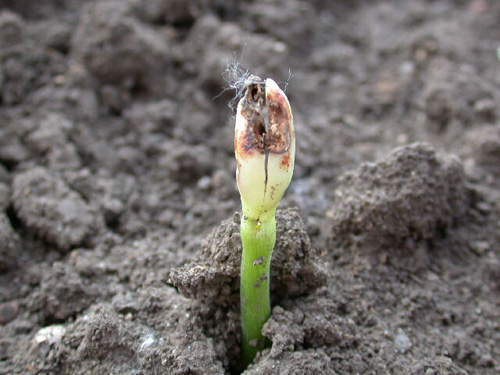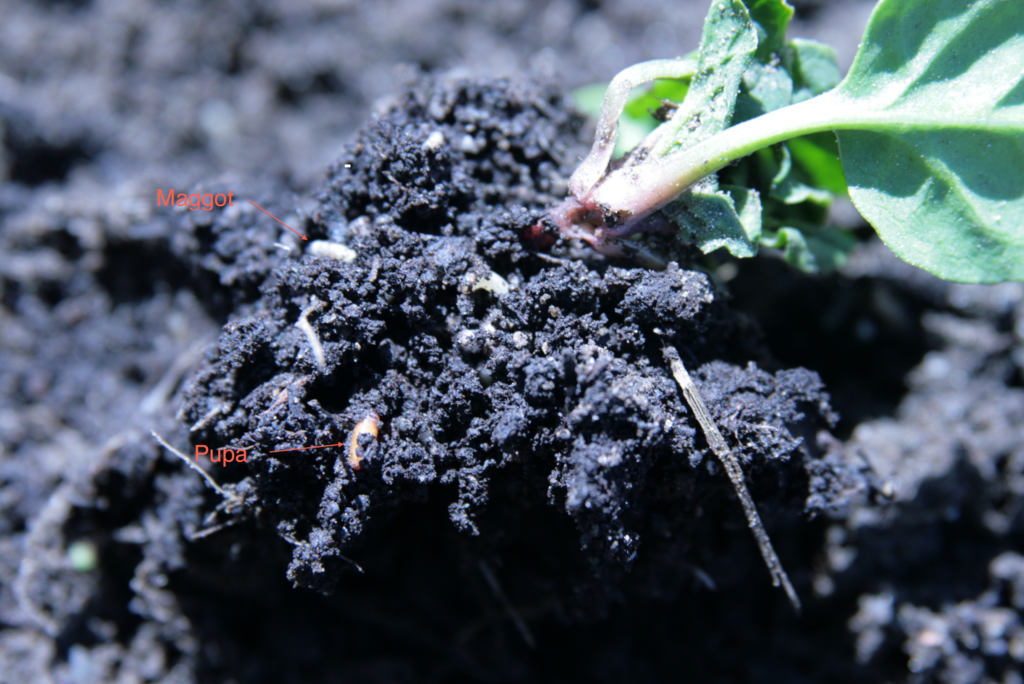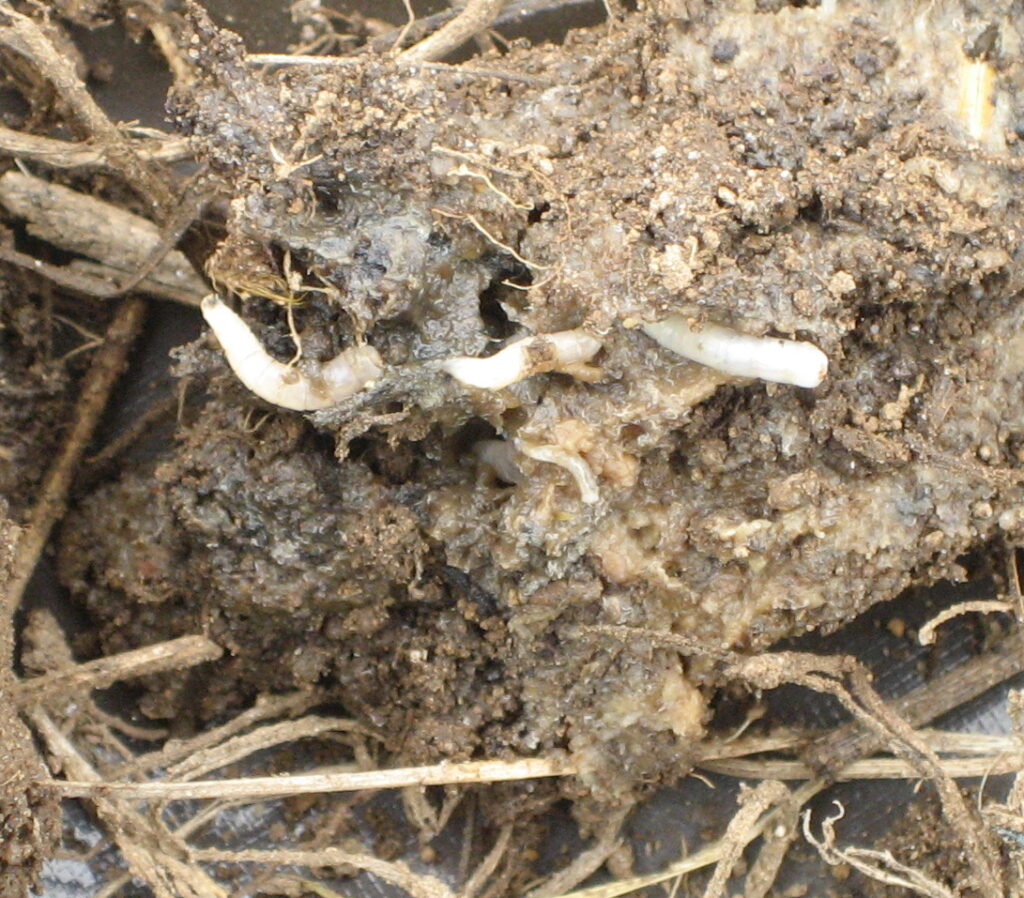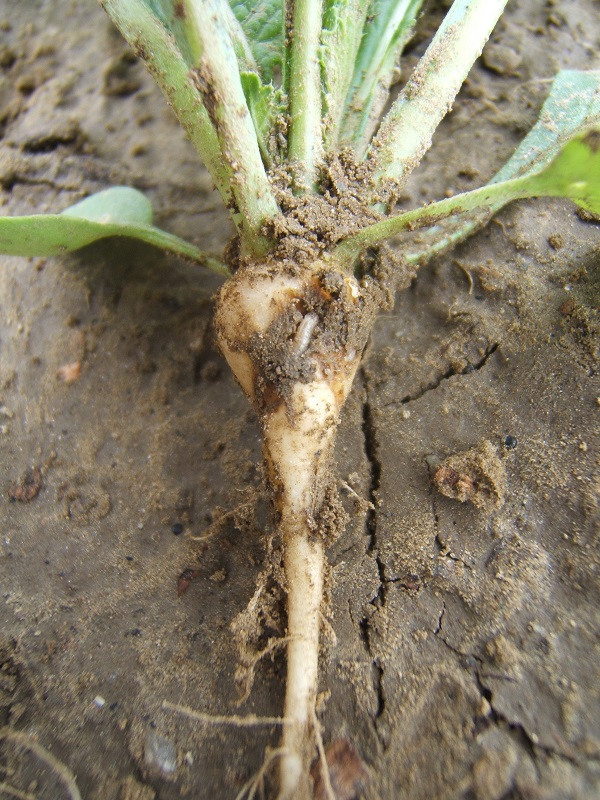
Pests: Seedcorn maggot (Hylemya platura), Onion maggot (Delia antiqua), Cabbage maggot (Delia radicum)
Pest identification and lifecycle, most common symptoms and crops affected:

Seedcorn maggot larvae feed on seeds and young seedlings of many crops (including corn, beans, beets, peas, spinach, onions and Brassicas). The first symptoms are usually poor germination (or failure of seedlings to emerge), or wilting transplants that have lost their roots to feeding. Symptoms can be difficult to distinguish from other problems — such as damping-off due to Pythium or other soilborne fungi, or wireworm feeding — at least until you dig around a bit and find the maggots.
There are two other common maggot problems in the Northeast, which are specific to certain crops: the onion maggot and the cabbage maggot (which is a problem in cabbage, broccoli, cauliflower, radish and other Brassica family members). All of these maggots are more likely to be problems early in the season, becoming less of a problem by late May/early June because there is much lower egg survival in warm soil.

The species of maggots are very hard to tell apart. It would be good to know which you have because the onion and cabbage maggots will become more of a problem year after year if crop rotation is not followed. And, especially with the cabbage maggot, using the wrong cover crop in a field could be a problem (you would not want to use tillage radish as a fall cover crop in a field you plan to plant to cabbage the following spring).
In contrast to the cabbage and onion maggots, the seedcorn maggot is not specifically attracted to a particular crop but rather is attracted to the smell of decaying organic matter. Seedcorn maggots have even been shown to be attracted to decaying soybean meal that was applied as a fertilizer at seeding or transplanting. The maggots can usually be found in the soil around and inside seedlings and seeds.

The adults of all these maggot species look like small houseflies. The prior season’s last generation of adults lay eggs that hatch into maggots, which feed for a while and then pupate late in the fall, overwintering in the soil as pupae. In early spring, they emerge as adults, fly around, and lay eggs either at the base of their favorite plants, or in the case of the seedcorn maggot, where they smell freshly decaying organic matter, such as compost or manure added to a field, decaying seeds (or as mentioned above, maybe even soybean meal added as a fertilizer), etc. The eggs hatch within two to four days at soil temperatures of 50 F.
Research has shown that peak emergence of the first three generations occurs when enough growing degree days (base 40 F) have accumulated:
- Seed corn maggot — 350, 1,080 and 1,800 degree days (base 40 F).
- Cabbage maggot — 450, 1,250 and 2,175 degree days (base 40 F).
- Onion maggot — 725, 1,750 and 2,975 degree days (base 40 F).
For predicting the peak emergence of these flies, (and thus, the greatest risk of them laying eggs by crops) degree day accumulation is calculated on a daily basis. To quickly see the degree day (base 40 F) accumulation for your area, you can use this map, provided by Maine State Climatologist Sean Birkel and the Maine Climate Office. Additionally, you can utilize the Climate Smart Farming Growing Degree Day Calculator to see the current accumulation, and forecasted accumulation of growing degree at your location. Make sure that the current date and location is correct for you, and then adjust the “GDD base” to 40 F. As you hover your cursor over the graph, you will see the current accumulation of growing degree days, as well as a forecast for the next six days and averages of prior years. Another good indicator of cabbage maggot flight is the blooming of the common roadside weed, yellow rocket (Barbarea vulgaris).

The first generation of seedcorn maggot usually causes the most damage. The adults prefer to lay eggs in wet soil. Crop seeds that germinate slowly are more vulnerable to attack. Crops that are planted in wet, and or cool soil, may be especially susceptible to damage because of slow growth.
Management options:
By the time you see damage, it is too late to control the problem using either cultural or chemical methods. Prevention is the key.
Avoid seeding fields (especially wet fields) too early. Seeds germinate more quickly and are less vulnerable in warmer and drier soils.
Disk and incorporate organic matter (such as a cover crop) at least four weeks before seeding to give it time to break down and make it less attractive to the flies.
Avoid applying manure or unfinished compost in late fall or early spring to heavy soils that you might want to plant early. Lighter, well-drained, sandy soils are less likely to have problems (because they warm up and dry out faster than others).
Row covers can be very effective to exclude egg-laying adults — but only if the maggot flies are coming from elsewhere. Remember, the flies overwinter in the soil as pupae. If you grew a susceptible cover crop, or applied manure in the fall, pupae may be there overwintering, and then flies could end up underneath your row cover. Replace covers after weeding operations. As soil temperatures rise, the first flight ends and crops grow large, covers can be safely removed.
If you need to replant, wait at least five days if maggots that you find are a quarter inch long; if they are smaller than that, wait at least 10 days to make sure they have pupated and will not damage the new seeds.
In the case of onion maggots and cabbage maggots, crop rotation can contribute to keeping populations low; greater distances are more effective. Fall tillage is recommended to bury crop residues and to expose overwintering pupae. Bury or haul away onion cull piles as the smell of rotting onions attracts the onion maggot fly. With Brassicas, cultivation that brings soil up around the stem may help encourage formation of adventitious roots; these may help compensate for root loss.
Biocontrol options:
From UMass Extension: Soil application of the entomopathogenic nematode Steinernema feltiae has shown efficacy against cabbage maggot in trials. Apply by treating transplants prior to setting in the field, in transplant water used in a water wheel transplanter, as a drench after transplanting, or a combination. Post-plant treatments are likely to be needed if maggot flight begins >1 week after transplanting. Rates of 100,000 to 125,000 infective juveniles per transplant have been shown to be needed to achieve reduction in damage. Nematodes need a moist soil environment to survive.
Source material attribution: Thanks to: Ruth Hazzard (UMass Vegetable Notes and The New England Vegetable Management Guide). References: Network for Environment and Weather Applications (NEWA) of NYS IPM Program; Ontario Ministry of Agriculture, Food and Rural Affairs online fact sheet.
